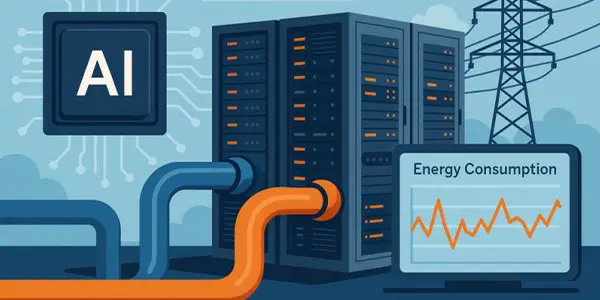
The U.S. gas market is experiencing a surge in capital expenditures, creating a wave of megaprojects that will dominate the energy landscape through 2030. Planned gas-fired capacity is set to reach nearly 80 GW, more than double what it was in the last five years (EIA, 2025). Key reasons for this growth include demand from AI and data centers, industrial electrification, and concerns about grid reliability.
For project managers, these market conditions mean they will face execution challenges, longer lead times, and higher costs. Understanding the market context now is crucial to staying ahead.
The Drivers Behind the Gas Comeback
Several major factors are driving renewed gas investment, creating a market that is both urgent and complex. Project managers must recognize these drivers to anticipate the challenges ahead. Key factors include:
- Data Center Demand: The rapid growth in AI and cloud computing is pushing utilities to secure reliable and dispatchable power that can operate around the clock without interruption (EIA, 2025).
- Industrial Electrification: As manufacturers shift from fossil fuels to electricity, the grid is starting to face higher capacity demands. This creates new pressures for planning and execution.
- Grid Reliability: Intermittent renewable energy generation means utilities must hedge its power deliveries with dispatchable gas assets to maintain a consistent supply. This adds layers of complexity to scheduling and resource allocation.
These drivers signal that project managers will face more ambitious timelines, heavier workloads, and a greater need for proactive planning throughout all phases of capital project execution. Staying informed on market trends will help teams anticipate challenges and prepare mitigation strategies before execution begins.
Supply Chain Backlogs
Backlogs at major turbine manufacturers are significant bottlenecks for project execution. Project managers need to grasp the domino effect of longer lead times and limited supply chains to manage expectations and plan realistically. For example:
- GE Vernova, Siemens Energy, and Mitsubishi Power are experiencing delivery backlogs that last multiple years, complicating procurement planning (Utility Drive, 2025)
- Even smaller turbines may take 3+ years to deliver, requiring coordination with EPCs and owners (Grid Monitor, 2025).
These delays contribute to rising costs and increased pressure on project budgets and timelines.
To mitigate these bottlenecks, project teams can take several steps:
- Adjust CAPEX forecasts to account for extended procurement windows.
- Explore early contract lock-ins to hedge against inflation.
- Work with suppliers on scenario planning to avoid cascading delays.
Supply chain delays are no longer minor annoyances; they require active mitigation and adjustments to long-term schedules. Project managers who foresee these challenges can lower risks and achieve more reliable project outcomes.
EPC Bottlenecks
Capacity constraints within the EPC sector are slowing down the entire gas buildout. Project teams need to be proactive in addressing these risks and planning for labor, financing, and operational limitations.
Some key issues include:
- Contractor shortages and a lack of experienced workers are slowing down project execution.
- Tighter labor markets and rising financing costs are putting extra pressure on schedules and budgets.
Developers are increasingly using repeatable project templates and design-build partnerships to reduce risk, but execution challenges remain significant.
Practical steps for project delivery teams include:
- Treat EPC capacity as a formal risk factor during early planning.
- Use framework agreements with contractors to secure scarce resources.
- Strengthen coordination between owners, contractors, and EPCs to prevent bottlenecks and misalignment.
PC bottlenecks highlight the need for structured project controls. Anticipating delays, maintaining clear communication with contractors, and leveraging technology will help teams navigate capacity constraints successfully.
Rising Costs and Inflation Pressures
The sharp rise in gas plant construction costs is forcing project managers to reassess budgets and risk management strategies. For instance:
Gas plant costs have tripled in just a few years, going from about $800 per kW in 2020 to between $2,000 and $2,500 per kW in 2024 (Gas Outlook, 2025). This escalation means that old benchmarks no longer apply, and every project team must adapt to today’s pricing realities.
Some practical steps to stay ahead include:
- Benchmarking costs frequently as historic references can be outdated and misleading.
- Building inflation scenarios into cost models and risk registers to avoid budget surprises. Read more about how to account for inflation on project budgets.
- Aligning stakeholders early to manage scope vs. budget trade-offs before execution begins.
Strategic Shifts in Gas Capital Expenditures
Utilities are no longer investing in just turbines. New gas projects now often include carbon capture, ammonia blending, or other low-carbon technologies. These additions help manage the variability of renewable energy and achieve emissions targets. However, they also introduce new layers of scope, technical complexity, and coordination for project managers.
Recent examples highlighting this shift include:
- S.: JERA and ExxonMobil’s Baytown project will produce 900,000 t/y of low-carbon hydrogen and over 1 Mt/y of ammonia using CCS.
- Europe: EnBW will take 100,000 t/y of ammonia from Norway’s Skipavika Green Ammonia project starting in 2027.
- Middle East: Mitsui, ADNOC, and Fertiglobe are developing the Al Ruwais facility in the UAE to produce 1 Mt/y of clean ammonia with CO₂ capture by 2027.
These shifts mean more complex execution environments, tighter integration between disciplines, and greater pressure on procurement and scheduling. But these changes also present chances to show leadership in delivering valuable, future-ready energy projects.
A Global View on Gas Capital Expenditures
While the U.S. tops in planned capacity, other regions are pursuing different strategies that reshape costs and risks.
- United States: Quickly increasing gas production, but dealing with supply chain issues and permitting difficulties.
- Europe: Combining gas with offshore wind and nuclear, using redesigned CfDs to stabilize investment interest.
- Asia: China and Japan are moving forward with ammonia co-firing alongside gas to meet demand and emissions targets.
This global landscape demonstrates that project risk profiles differ significantly by region.
Implications for the Process Industry
In this environment, success means anticipating risk and building resilience into every stage of project controls. Professionals in the process industry should take four immediate actions:
- Update cost databases to reflect today’s CAPEX levels.
- Secure OEM slots and EPC capacity early, even at premium terms.
- Use unified tools to connect budgets, schedules, and resources.
- Build scenarios for supply-chain delays and financing shocks.
These 4 actions will reduce surprises, protect margins, and make portfolios more resilient across regions and contract types.
Implications for Project Managers

The increase in U.S. gas capital expenditures translates into more megaprojects, higher execution risk, and greater pressure on timelines and budgets. Project managers need to adjust to longer lead times, higher costs, and more uncertainty in the supply chain. To succeed, capital project teams should:
- Integrate project controls software to unify schedules, budgets, and resource management in one platform.
- Centralize data across owners, contractors, and EPC teams to reduce miscommunication and prevent costly rework.
- Use scenario planning and early warning systems to anticipate delays or cost overruns before they impact the project.
- Leverage repeatable templates and standardized workflows to streamline execution while maintaining oversight of critical dependencies.
Capital project management software like Cleopatra Enterprise help teams manage these complexities. They offer real-time dashboards, automated reporting, and actionable insights that help keep projects on track. By combining disciplined execution with smart technology, project managers can reduce risk, improve efficiency, and deliver high-value capital projects despite market pressures.
U.S. gas-fired capital expenditures are moving faster than hydrogen or nuclear, but execution challenges are growing. Project managers who anticipate supply chain constraints, rising costs, EPC bottlenecks, and who leverage the right software tools will be best positioned to deliver projects on time, on budget, and with reduced risk. In a market defined by urgency and complexity, proactive management is a vital competitive advantage.
According to Dodge Construction Network’s survey, 70% of owners and contractors agree that better communication and coordination across…
Operational efficiency in project management is about achieving more with less: delivering projects on time and within budget…
Related resources

Reactive VS Proactive Project Cost Management
As a Project Controls Expert at Cleopatra Enterprise, Stephanie Ritchie sees a lot of common mistakes in the field, one of them being reactive instead of proactive.
Read blog article
The Impact of Inflation on Construction Project Budgets
Inflation is a factor that can quietly erode project budgets long before anyone realizes it. In construction and other capital-intensive industries, where timelines often stretch into years, even a small annual price increase can compound into major cost overruns over time. As project managers, cost estimators, and controls professionals, understanding…
Read blog article